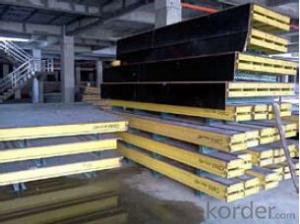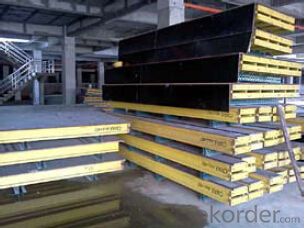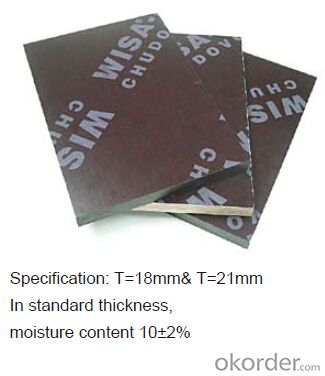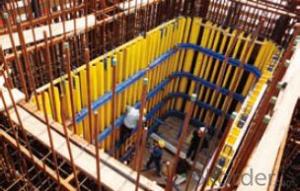Plywood Formwork systems for formwork and scaffolding
- Loading Port:
- Tianjin
- Payment Terms:
- TT OR LC
- Min Order Qty:
- 50 m²
- Supply Capability:
- 1000 m²/month
OKorder Service Pledge
Quality Product, Order Online Tracking, Timely Delivery
OKorder Financial Service
Credit Rating, Credit Services, Credit Purchasing
You Might Also Like
Plywood --- make perfect concrete surface
WISA-Form Birch is a coated special plywood using in the formwork systems where high
requirements are set on the concrete surface and the times of reuses.
With CNBM timber beam & WISA plywood, the formwork is low weight but high load capacity, it is
widely used in construction.
Characteristics:
◆ Component with high standardization.
◆ Assembling in site, flexible application.
◆ Light weight, easy transportation and storage.
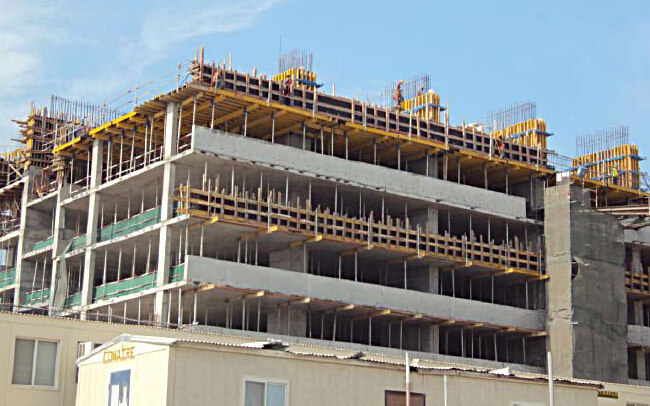
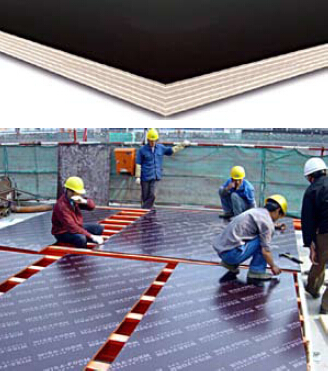
- Q: What are the considerations when designing steel formwork for columns?
- When designing steel formwork for columns, several considerations need to be taken into account. Firstly, the load-bearing capacity of the formwork needs to be determined based on the weight of the concrete and any additional loads that may be applied. The formwork should also be designed to withstand the pressure exerted by the fresh concrete during pouring and curing. Another important consideration is the size and shape of the column. The formwork needs to be customized to match the dimensions and contours of the column to ensure a precise and accurate mold. Additionally, the formwork should be designed to allow for easy installation and removal, as well as easy access for concrete pouring and finishing. Durability is also a significant factor. The steel formwork must be sturdy and robust enough to withstand the repetitive use and handling during the construction process. It should be able to resist wear and tear, as well as any potential impacts or vibrations that may occur on the construction site. Furthermore, safety considerations are paramount. The formwork should be designed to provide a stable and secure working platform for the workers involved in the installation and pouring of concrete. Adequate precautions must be taken to prevent any potential accidents or collapses. Lastly, cost-effectiveness is an important consideration. The design should aim to minimize material and labor costs while still meeting the required strength and durability standards. Efficient use of materials and ease of assembly and disassembly can contribute to cost savings. Overall, when designing steel formwork for columns, considerations such as load-bearing capacity, column size and shape, durability, safety, and cost-effectiveness are crucial to ensure a successful and efficient construction process.
- Q: Can steel formwork be used for hotel construction projects?
- Yes, steel formwork can be used for hotel construction projects. Steel formwork is a versatile and durable solution for constructing concrete structures, including hotels. It offers several advantages such as high strength, durability, and reusability. Steel formwork is capable of withstanding the pressure exerted by wet concrete and can be easily assembled and dismantled, making it suitable for use in various construction projects, including hotels. Additionally, steel formwork provides a smooth and accurate finish to concrete structures, ensuring high-quality construction.
- Q: Are there any safety considerations when using steel formwork?
- When using steel formwork in construction projects, it is important to take several safety considerations into account. Firstly, the weight and size of the steel formwork panels make handling and installation physically demanding. To prevent accidents and injuries, it is crucial to have trained personnel and proper lifting equipment to safely handle and position the panels. Secondly, stability during concrete pouring is vital, so the steel formwork should be securely supported and braced. This can be achieved by implementing anchoring and shoring systems, which will prevent collapse or displacement of the formwork and reduce the risk of serious accidents. In addition, working at heights while installing or removing the steel formwork can lead to falls. To mitigate this risk, suitable fall protection measures such as guardrails, safety nets, or personal fall arrest systems should be provided to prevent workers from falling from elevated surfaces. Furthermore, steel formwork may have sharp edges or protruding parts that can cause lacerations or puncture wounds. To minimize the risk of injury, workers should be equipped with appropriate personal protective equipment (PPE) including gloves, safety boots, and eye protection. Moreover, regular inspections of the steel formwork should be conducted to identify any signs of damage or deterioration. Prompt replacement of damaged or weakened components is essential to maintain the structural integrity and safety of the formwork system. Finally, effective communication and coordination among workers are essential to prevent accidents. Clear instructions, training, and supervision will ensure that all workers understand and adhere to the safety procedures when using steel formwork. In conclusion, by considering these safety measures and implementing appropriate precautions, the risks associated with using steel formwork can be minimized. This will create a safer working environment for construction personnel.
- Q: What are the different types of formwork bracing used in steel formwork?
- In steel formwork, there are various types of formwork bracing, each with its own unique features and benefits. Here are some of the most commonly used types: 1. Adjustable Steel Bracing: This bracing consists of adjustable steel tubes or rods that can be extended or retracted easily to the desired length. It allows for quick and easy installation and adjustment, making it ideal for projects with varying formwork heights. 2. Cross Bracing: Cross bracing involves diagonal steel members placed to create an "X" shape between vertical supports. It provides lateral stability to the formwork system and helps prevent buckling or deformation. 3. Tie Rod Bracing: Tie rod bracing uses threaded steel rods connected through formwork panels to provide extra strength and stability. It is commonly used in large-scale formwork systems that need to support high loads. 4. External Bracing: To increase stability against wind forces, taller formwork structures often use external bracing. Steel members are installed on the exterior side of the formwork system to resist lateral movement and maintain structural integrity. 5. Kickers: Kickers are diagonal bracing elements installed between formwork panels and the ground or a solid anchor point. They transfer lateral forces and prevent the formwork from tilting or collapsing. 6. Strut Bracing: Strut bracing involves placing steel struts or props vertically between the formwork panels and the ground. It provides additional support to prevent horizontal movement and ensure the stability of the formwork system. 7. Flying Bracing: When formwork needs support from above, such as in bridge construction or overhead structures, flying bracing is used. Bracing elements are suspended from overhead supports to provide stability and prevent formwork deformation. Each type of formwork bracing offers advantages and is chosen based on specific project requirements, including formwork height and size, expected loads, and site conditions. A combination of different bracing types may also be used to ensure optimal stability and safety.
- Q: Can steel formwork be used for both interior and exterior applications?
- Yes, steel formwork can be used for both interior and exterior applications. Steel formwork is durable, strong, and resistant to weather conditions, making it suitable for various construction projects. It is commonly used for both interior and exterior applications such as building walls, columns, slabs, beams, and other structural elements. Steel formwork provides a stable and rigid framework for concrete pouring, ensuring the accuracy and quality of the final construction. Additionally, steel formwork can be reused multiple times, making it a cost-effective choice for both interior and exterior applications.
- Q: How does steel formwork affect the overall vibration resistance of the structure?
- Steel formwork can significantly enhance the overall vibration resistance of a structure. The use of steel as a formwork material provides several advantages that contribute to increased structural stability and reduced vibrations. Firstly, steel formwork is known for its high strength and rigidity. It provides a robust framework that can withstand the dynamic forces and loads that a structure experiences during its lifetime. This increased strength helps in minimizing any potential vibrations caused by external factors such as wind, earthquakes, or heavy machinery operating nearby. Secondly, steel formwork offers a precise and accurate construction process, ensuring a tight fit and proper alignment of structural elements. This precise assembly reduces any potential gaps or unevenness, which can be a source of vibration amplification. By minimizing these irregularities, the overall vibration resistance of the structure is improved. Furthermore, steel formwork has excellent dimensional stability, meaning it does not shrink, expand, or warp under changing environmental conditions. This stability ensures that the structure maintains its integrity and does not undergo any significant deformations that could lead to increased vibrations. In addition, steel formwork is highly resistant to corrosion and deterioration, ensuring its long-term durability. This resistance to degradation prevents any weakening of the structure over time, which is crucial for maintaining its vibration resistance. Moreover, steel formwork offers a higher load-carrying capacity compared to other formwork materials. This increased load-bearing capability allows for the construction of more robust and resilient structures that can withstand higher dynamic loads without experiencing excessive vibrations. Overall, the use of steel formwork positively impacts the overall vibration resistance of a structure by providing strength, rigidity, precision, dimensional stability, corrosion resistance, and increased load-carrying capacity. By incorporating these characteristics, steel formwork helps to minimize vibrations and ensures the structural integrity and safety of the building.
- Q: Can steel formwork be used for structures with high load-bearing requirements?
- Yes, steel formwork can be used for structures with high load-bearing requirements. Steel is known for its high strength and durability, making it a suitable choice for heavy-duty applications. Steel formwork provides excellent support during the construction process, allowing for the creation of structures that can withstand significant loads. Additionally, steel formwork offers superior dimensional stability, ensuring that the structure maintains its shape and can bear the required loads over time. Combined with proper reinforcement and design, steel formwork can effectively handle high load-bearing requirements in various construction projects.
- Q: Are there any specific considerations for using steel formwork in areas with limited power supply?
- Yes, there are several specific considerations for using steel formwork in areas with limited power supply. Firstly, since steel formwork requires power tools for installation and removal, alternative methods such as manual labor or non-powered equipment may need to be employed. Additionally, the limited power supply may affect the availability of electricity for welding, which is often required for steel formwork assembly. Therefore, alternative joining methods such as bolting or mechanical fastening may need to be explored. Finally, the transportation and storage of steel formwork components in areas with limited power supply may require additional planning to ensure their accessibility and protection.
- Q: What are the common safety guidelines when working with steel formwork?
- To ensure the well-being of workers and prevent accidents, it is important to adhere to several common safety guidelines when working with steel formwork. These guidelines encompass the following: 1. Utilizing Personal Protective Equipment (PPE): Workers must wear the appropriate PPE, which includes safety helmets, safety glasses, gloves, and steel-toed boots. This will safeguard them against potential hazards such as falling objects and cuts. 2. Emphasizing Training and Competency: Workers should undergo thorough training on the proper usage and handling of steel formwork. They should possess the necessary knowledge and skills to safely perform their assigned tasks. 3. Conducting Inspections: Regular inspections of the steel formwork must be carried out prior to and during its use. The objective is to ensure that it is in good condition and free from defects. Any damaged or faulty parts should be promptly repaired or replaced. 4. Employing Proper Handling Techniques: Due to the weight and unwieldiness of steel formwork, it is imperative to utilize correct lifting techniques and mechanical aids when moving or positioning it. This will prevent musculoskeletal injuries caused by excessive strain or overexertion. 5. Ensuring Secure Installation: The formwork must be securely installed and braced to prevent collapse or displacement during the pouring of concrete. It should be aligned and supported properly to maintain stability throughout the construction process. 6. Implementing Fall Protection: Adequate fall protection measures, such as guardrails or safety harnesses, should be in place when working at heights. Additionally, workers should exercise caution on slippery surfaces and take necessary precautions to prevent slips, trips, and falls. 7. Communicating Hazards: Clear signage and warnings should be prominently displayed to alert workers to potential hazards and provide instructions on safety procedures. Effective communication and coordination among workers are also essential in preventing accidents. 8. Regular Maintenance: Regular maintenance and cleaning of the steel formwork are crucial to remove debris, rust, or other materials that could compromise its integrity. This will contribute to its overall safety and longevity. By adhering to these common safety guidelines, the risk of accidents and injuries can be significantly reduced, ultimately creating a safer work environment for all individuals involved.
- Q: What are the factors to consider when selecting steel formwork?
- When selecting steel formwork, there are several factors to consider. 1. Strength and durability: Steel formwork should be strong enough to withstand the weight of the concrete and the forces applied during the pouring and curing process. It should also be able to withstand multiple uses without losing its structural integrity. 2. Flexibility and adaptability: The formwork should be able to be easily adjusted and modified to accommodate different shapes and sizes of concrete elements. This is particularly important in construction projects that involve complex or irregular structures. 3. Ease of assembly and dismantling: The formwork system should be quick and easy to assemble and dismantle, as this can significantly impact the overall construction timeline. The use of standardized components and a simple connection system can contribute to faster assembly and dismantling. 4. Surface finish: The quality of the surface finish of the concrete is important, especially for architectural projects. Steel formwork should provide a smooth and even surface, without any visible marks or imperfections, to ensure a high-quality end result. 5. Cost-effectiveness: The overall cost of the formwork system, including the initial investment, maintenance, and reusability, should be considered. While steel formwork may have a higher upfront cost compared to other materials, its durability and reusability can make it a cost-effective choice in the long run. 6. Safety: The safety of workers during the construction process is paramount. Steel formwork should be designed and manufactured with safety features such as non-slip surfaces, secure connections, and adequate bracing to prevent accidents or collapses. 7. Environmental impact: The environmental impact of the formwork material should also be taken into account. Steel formwork is often considered more environmentally friendly compared to traditional timber formwork due to its reusability and recyclability. By considering these factors, construction professionals can make an informed decision when selecting steel formwork that meets their project requirements and delivers optimal results.
Send your message to us
Plywood Formwork systems for formwork and scaffolding
- Loading Port:
- Tianjin
- Payment Terms:
- TT OR LC
- Min Order Qty:
- 50 m²
- Supply Capability:
- 1000 m²/month
OKorder Service Pledge
Quality Product, Order Online Tracking, Timely Delivery
OKorder Financial Service
Credit Rating, Credit Services, Credit Purchasing
Similar products
Hot products
Hot Searches
Related keywords
